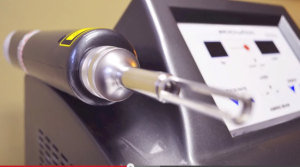 Toenail fungus can turn your beautiful clear nails into brittle, yellow thick talons.
Toenail fungus can turn your beautiful clear nails into brittle, yellow thick talons.
The changes make your feet look ugly. You rule out wearing sandals any time of the year. Most home remedies, topical treatments and drugs are ineffective or cause undesirable side effects.
Patients who receive prescription medication must undergo routine bloodwork to ensure the drug is not affecting their liver. However, laser treatment for toenail fungus may help to clear the problem without the side effects.
Toenail Fungus is a Big Problem
Toenail infections are a huge problem. According to podiatrists, these fungal infections affect 70 percent of all patients. Some may be unaware the problem is related to an infection and believe that ugly nails are a part of the aging process.
The Most Likely Candidates
You’re likely to experience toenail fungus if your feet are in a moist or wet environment. Athletes, lifeguards and fishermen have an increased chance of developing the condition. It’s also more common in older individuals whose immune systems have become weaker in fighting off the problem.
Prescription Medication Sometimes Works
Lamisil is the most common oral prescription treatment. It works for about 2/3 of the patients using it, according to information approved by the FDA.
In rare cases, the drug is associated with serious liver damage. It also carries a warning of side effects like headache, diarrhea, changes in taste and rashes. The drug’s manufacturer reports a 15 percent relapse rate, a year after the treatment.
FDA Clears Laser for Toenail Fungus Treatment
Doctors began using lasers for off label treatment of nail fungus in 2009. In 2010, the FDA approved the PinPointe laser for this use. The GenesisPlus and CoolBreeze devices won approval for this use in 2011.
Pros of Laser Treatment
• No side effects
• Better success rates
• Possible cure for nail fungus
Effective Treatment Without Side Effects
At least one study has shown improvement in 85 percent of nails with toenail fungus. This is significantly better than Lamisil’s reported 66 percent success rate. In addition, the laser treatment is reported to have no side effects. Patients don’t experience the headaches or gastric problems associated with Lamisil. They also don’t subject their liver to possible damage.
May Eliminate Recurrence
Toenail fungus is difficult to cure. One untreated spore lead to a recurrence. Also, there is always the chance of reinfection through the same conditions that lead to the initial infection.
However, the success rate of the treatment makes the recurrence much less likely. There is a minimal reinfection within the first five years after treatment, according to PinPointe’s founder.
Cons of Laser Treatment
• Expensive
• Not covered by insurance
Laser Therapy Considered a Cosmetic Procedure
Most insurance companies classify laser therapy for nail fungus a cosmetic procedure. They don’t cover the cost of the therapy. As a result, the patient is often left to pay the bill outright. While costs vary by region, they often are in the $1000 range.
Options for Home Remedies
A quick search of the internet turns up several home remedies. This includes using vinegar, tea tree oil, bleach and Vicks VapoRub. They generally do not work.
The fungus lives under the nail and home treatments simply can’t reach the root of the problem. In addition, the fungus comes as several different types of organisms. So it’s more difficult for home remedies. What works for one individual may not work for others. On the other hand, laser treatment for toenail fungus penetrates the nail and kills most organisms.


